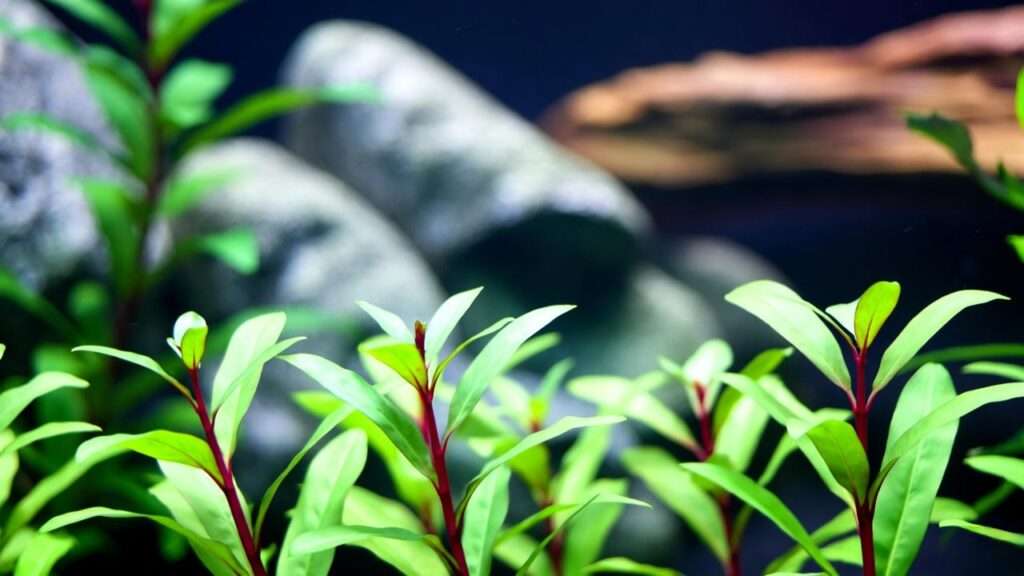That flash of red on a stem, the striking crimson against a backdrop of green—it’s not just a pretty color or a random aesthetic quirk. A red stem plant is often sending a crucial signal, one that many plant parents mistake for normal variation or overlook entirely, leading to long-term health issues.
As plant care experts, we know that deciphering this color code is the key to thriving foliage. Red stems can signal peak health and genetic vibrancy in some species, yet in others, they scream distress, indicating everything from nutrient deficiencies to life-threatening root problems. If your plant is struggling, or if you simply want to unlock its full, colorful potential, you need to understand the science behind the splendor.
This comprehensive guide will provide the expert knowledge to accurately identify your specific red-stemmed variety, master the care secrets required to intensify its color, and definitively solve the mystery of why its stems might be struggling, patchy, or dull. Stop guessing and start nurturing—your vibrant, healthy plants are waiting.
2. The Science Behind the Splendor: Why Stems Turn Red (E-E-A-T Builder) 🔬
Before we jump into specific care routines, understanding the why is essential. This is the difference between blindly following instructions and truly mastering the art of plant care. When a stem turns red, it’s not magic; it’s botany in action.
2.1. Anthocyanins: The Plant Pigment Responsible
The striking red, purple, or even bluish colors you see in plant tissues are due primarily to a group of water-soluble pigments called Anthocyanins. These pigments are housed within the plant’s cell vacuoles, and they serve several critical biological functions:
- Photoprotection (Internal Sunscreen): This is their most common and essential role. When plants, especially newly emerging leaves or tender stems, are exposed to intense sunlight, they synthesize anthocyanins. This red pigmentation acts as a shield, protecting the delicate chlorophyll (green pigment) from photo-oxidation and damaging UV radiation. Think of it as the plant applying its own, natural SPF.
- Attracting Pollinators and Seed Dispersers: While more common in flowers and fruits, some stem colors can also play a subtle role in ecological interactions.
- Stress Indicators: Anthocyanin production often ramps up under stress conditions like cold temperatures, drought, or specific nutrient deficiencies (especially phosphorus). The plant redirects its energy toward defense, producing this protective pigment.
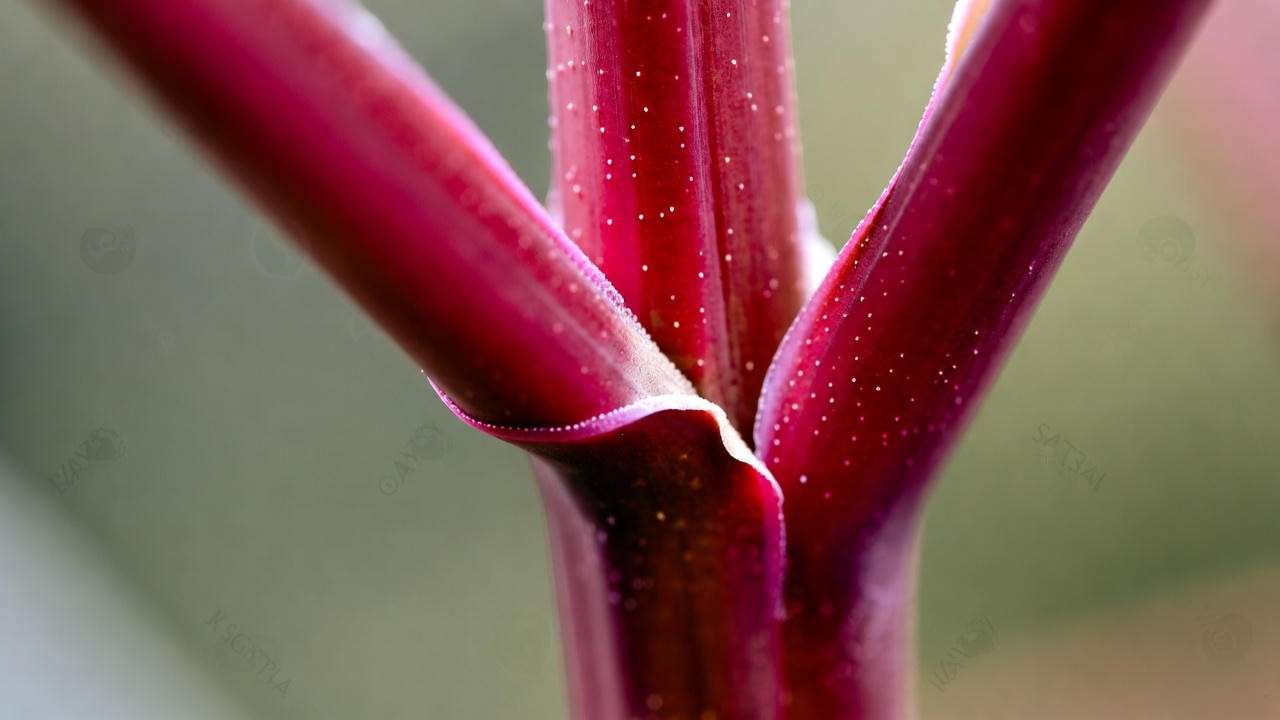
2.2. Two Sides of the Red Coin: Stress vs. Genetic Health
The key to proper diagnosis is distinguishing between a vibrant red caused by healthy genetics and one caused by environmental distress.
| Condition | Appearance of Red | What It Signals | Recommended Action |
| Genetic Health | Uniform, bright, deep, vibrant red or pink. Often concentrated in new growth. | The plant is getting optimal light and is perfectly healthy. | Maintain current care routine. |
| Phosphorus Stress | Dull, muddy, or purplish-red. Often on the underside of leaves and older stems. | Nutrient deficiency or cold-induced stress limiting uptake. | Check fertilizer, soil pH, and ambient temperature. |
| Light Stress (Too Much) | Patchy, scorched-looking red or brown spots on stems facing the light. | Sunburn or excessive light intensity. | Move the plant slightly away from the light source. |
| Water Stress/Rot | Dark, purplish-black at the base of the stem, often soft or mushy. | Root Rot or excessive moisture. | Inspect roots immediately and adjust watering practices. |
3. Identification Guide: Top 5 Popular Red Stem Plant Varieties 🌿
Identification is the first step in successful care. Because the care routine for a naturally red-stemmed plant is drastically different from one where the red is an abnormality, you must know what you have. Here are the top five red-stemmed plants frequently encountered in the home and garden.
3.1. The Iconic Houseplant: Fiddle Leaf Fig (Ficus lyrata) 🎻
The Fiddle Leaf Fig is notorious for its diva behavior, but its stems offer one of the best clues about its health.
- The Red Signal: New leaves emerge wrapped in a sheath (a modified stipule) that is a bright, striking red-to-maroon color. The petioles (the small stalks attaching the leaf to the main stem) also display this color, especially on new growth.
- Care Context: In the Ficus lyrata, this red color is a clear sign of peak health and active growth. As the leaf hardens and matures, the sheath will typically drop off, and the petiole will gradually turn green. If your fig is pushing out red growth, congratulations—you are providing it with the high light and consistent moisture it needs. If you see no new red stems for a long period, it’s a sign of dormancy or inadequate light.
3.2. The Terrarium/Aquatic Beauty: Alternanthera reineckii 🌊
This plant is common in aquascaping and humid terrariums, where its vibrant color is highly prized.
- The Red Signal: The Alternanthera varieties are genetically programmed to produce high levels of anthocyanins, resulting in deep crimson, red, and pink colors on the undersides of the leaves and the entire stem structure.
- Care Context: For this plant, the intensity of the red color is directly proportional to the intensity of light and nutrient availability (specifically iron). If your Alternanthera is turning weak or greenish, it is severely light-starved and may also be lacking micronutrients. Maintaining that deep red stem requires powerful light (at least 2-3 watts per gallon in an aquarium) and regular fertilization.
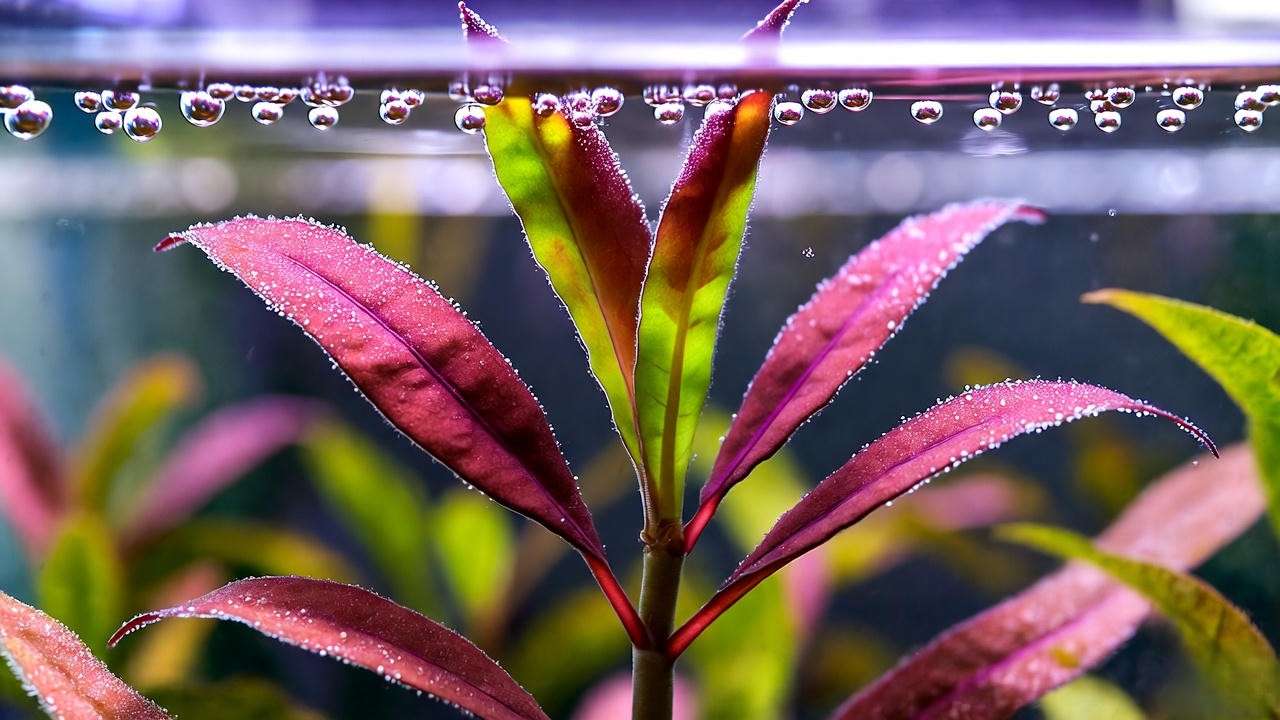
3.3. The Edible Indoor Gem: Swiss Chard (Garden Connection) 🥗
While often grown outdoors, Swiss Chard is a beautiful, edible plant that can be grown in containers indoors or on patios.
- The Red Signal: Known for its sturdy, ruby-red stalks (or ribs) that contrast vividly with its dark green, crinkled leaves. This is a purely genetic trait, celebrated in varieties like ‘Ruby Red’ or ‘Rhubarb Chard’.
- Care Context: As an edible plant, a lack of deep, vibrant color in the stalks can indicate insufficient nutrients, particularly nitrogen and potassium, or insufficient water. If the stalks are pale or spindly, increase feeding and ensure consistent moisture—not soggy, but not bone-dry either.
3.4. The Vibrant Accent: Red Aglaonema Varieties (Chinese Evergreen) 🌶️
The Chinese Evergreen family has expanded far beyond its green-and-white origins, with red varieties now dominating the market.
- The Red Signal: These varieties have an intricate genetic makeup that incorporates red and pink coloring across the stems and leaves. The petiole and lower stem often carry a deep pink or red blush that intensifies with age.
- Care Context: The Aglaonema is famed for its tolerance of lower light, but to achieve and maintain its most vivid red and pink stem coloring, it requires bright, indirect light. In deep shade, the coloring will often fade and the stems may appear greener, thinner, and less robust.
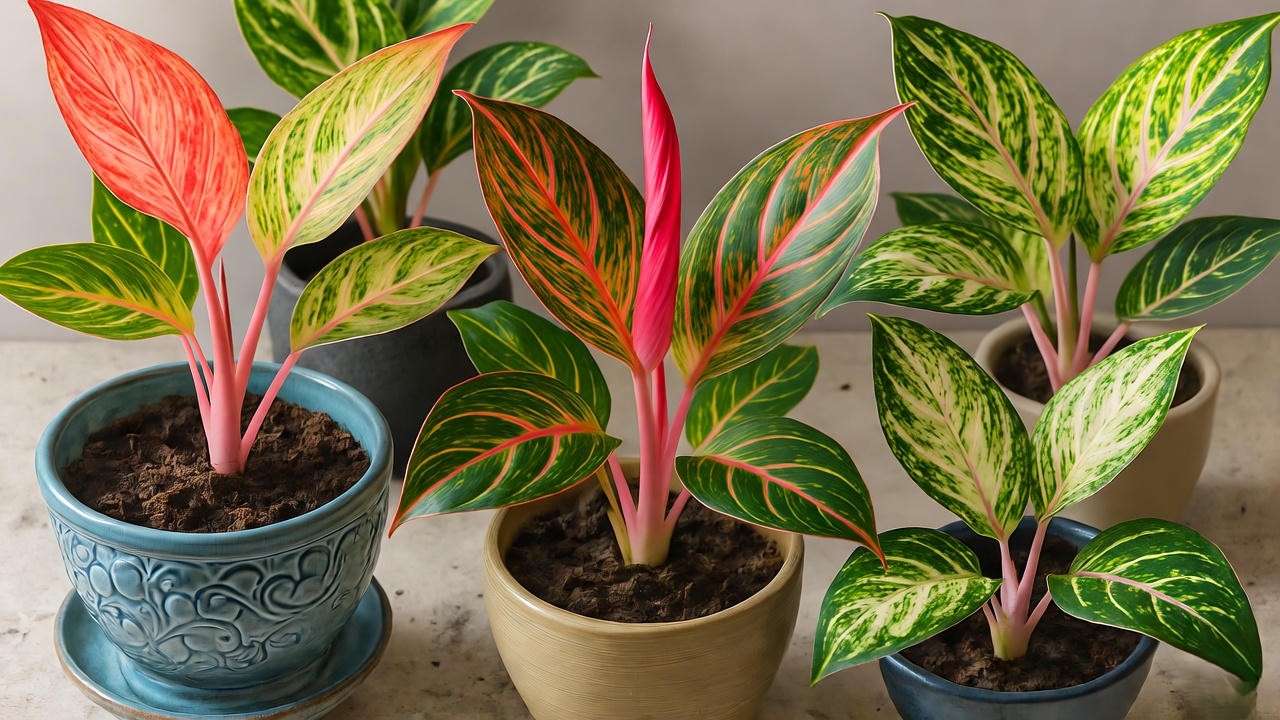
3.5. The Easy Indoor Option: Pink Polka Dot Plant (Hypoestes phyllostachya) 🌸
This small, busy plant is often used as a colorful filler or accent piece.
- The Red Signal: The stems connecting its heavily spotted leaves are often a delicate, light pink or reddish hue, especially when the plant is young and growing actively.
- Care Context: The biggest stem-related issue with the Polka Dot Plant is etiolation, or legginess. When the plant doesn’t get enough light, the red stems become long, thin, weak, and pale as it stretches desperately toward a light source. To maintain a compact, bushy plant with sturdy, colored stems, frequent pruning and bright light are essential.
4. Foundational Care Secrets for Red Stem Varieties (The “How-To” Guide) ✅
While care varies slightly by species, these four foundational pillars are non-negotiable for maximizing the health and color of any red-stemmed plant. These secrets focus on environmental control, which is the most effective way to manage anthocyanin production.
4.1. Optimal Light Conditions: The Pigment Accelerator ☀️
Light is the single greatest determinant of stem color. Remember: red is a type of sunscreen.
- Rule of Thumb: All red-stemmed plants, whether the color is genetic or a stress response, need bright, indirect light to thrive. This intensity is required for the plant to produce the energy necessary for vibrant coloration without causing leaf or stem scorching.
- The Danger of Direct Sun: While some direct morning sun can be beneficial (especially for Ficus or Alternanthera), strong afternoon sun is harsh. This can lead to photodamage, where the red color appears scorched or burned, often developing into ugly, brown, crispy patches on the stem. Filter the light using a sheer curtain or set the plant a few feet back from a sunny, south- or west-facing window.
- Expert Insight: Rotate your plant weekly. This ensures all stems receive uniform light exposure, preventing the plant from developing lopsided growth and promoting an even, deep color saturation across its entire structure.
4.2. Watering Needs and Drainage Essentials 💧
Watering habits are the primary cause of stem-related death in houseplants. For plants whose stems may already be stressed (showing red due to nutrient lockdown or cold), poor watering is a death sentence.
- Vulnerability: Red stems are often thicker and more rigid than green stems, meaning they are particularly vulnerable to root rot if overwatered. Chronic soggy conditions prevent roots from taking up oxygen, causing them to die and leaving the stem base susceptible to fungal infection.
- Method: Adopt the “Slightly Dry” rule. Allow the top 1-2 inches of soil (or more, depending on the plant size) to dry out completely before watering thoroughly. When you water, ensure the plant is soaked until water flows freely from the drainage hole, and then immediately discard the excess water from the saucer. Never let the pot sit in standing water.
- Drainage: Why excellent drainage (potting mix and pot hole) is non-negotiable. Using a chunky, well-aerated potting mix—like one containing perlite, orchid bark, and coco coir—is the best preventative measure against root rot.
4.3. The Right Soil Mix and Repotting Frequency 🔄
The health of the stem begins at the root ball. Poor, compacted soil suffocates roots and leads to nutrient deficiencies that manifest as stem discoloration.
- Mixture: The ideal mix varies, but it should prioritize aeration. For tropical varieties like Aglaonema or Ficus, use an aroid-style mix that is chunky, airy, and fast-draining. Avoid cheap, dense potting soil which compacts quickly and cuts off oxygen supply to the roots.
- Repotting: Signs your red stem plant needs a new home include water running straight through the pot (indicating a dense root ball), roots emerging from the drainage hole, or mineral build-up crusting on the soil surface. Repot only when the plant is actively growing (spring/summer) and move up only one pot size at a time to avoid overwhelming the roots with too much soil volume.
4.4. Fertilization: Feeding the Pigment 🍎
If your plant is turning red due to distress, a phosphorus deficiency is often the culprit.
- Phosphorus & Magnesium: These are the essential micronutrients intrinsically linked to energy transfer (ATP) and cell health, necessary for both growth and anthocyanin production. A lack of phosphorus is a classic reason why many plants will develop a dull, purplish-red tinge on older stems and leaves.
- Schedule: Use a balanced liquid fertilizer (e.g., a 10-10-10 or a slightly higher-P formula like 10-20-10) diluted to half strength during the active growing season (spring through early fall).
- Warning: The risk of over-fertilization is acute. Excess fertilizer salts can burn sensitive root tips, paradoxically leading to the inability to take up water and nutrients, which can stress the plant and cause stem discoloration. Flush the soil with plain water once every 4-6 weeks to clear out salt residue.
5. Troubleshooting: Why Your Red Stem Plant is Struggling (Symptom-Fix Diagnosis) 🚑
When the red isn’t a beautiful feature but a cause for concern, use this expert-level symptom guide to accurately diagnose and fix the problem.
5.1. Symptom 1: Red Color Fading or Turning Greenish-Brown
- Visual Cue: The stems are losing their deep, vibrant color (if they were naturally red), or a stress-induced purplish-red is simply disappearing without the plant looking healthier.
- Diagnosis: This is most commonly due to light deficiency (the plant stops synthesizing protective red pigment because it is in a shaded area) or, paradoxically, too much harsh, direct sun (the red turns to brown/scorch).
- The Fix:
- If Fading: Move the plant to a location that provides brighter, indirect light. This is the simplest solution.
- If Browning/Scorching: Move the plant slightly back from the window or use a sheer curtain to diffuse the light, preventing cellular damage.
5.2. Symptom 2: Stems Are Soft, Mushy, and Blackened
- Visual Cue: The base of the stem feels soft and waterlogged to the touch; the color is a dark, sickly purplish-black; or the plant is suddenly drooping, even though the soil is wet.
- Diagnosis: This is a clear case of Root Rot (a fungal or bacterial infection caused by chronic overwatering and poor drainage). The stem tissue is actively decaying.
- The Fix: This requires emergency intervention:
- Gently unpot the plant and remove all the soil.
- Use sterilized shears to prune away any roots that are black, mushy, or smell rotten. Cut back to healthy, firm, white root tissue.
- Treat the remaining roots with a fungicidal solution or a mixture of hydrogen peroxide and water (1 part 3% peroxide to 2 parts water) to kill any remaining pathogens.
- Repot immediately into a clean pot with fresh, extremely well-draining, airy potting mix.
- Do not water for several days, allowing the plant to recover from the stress.
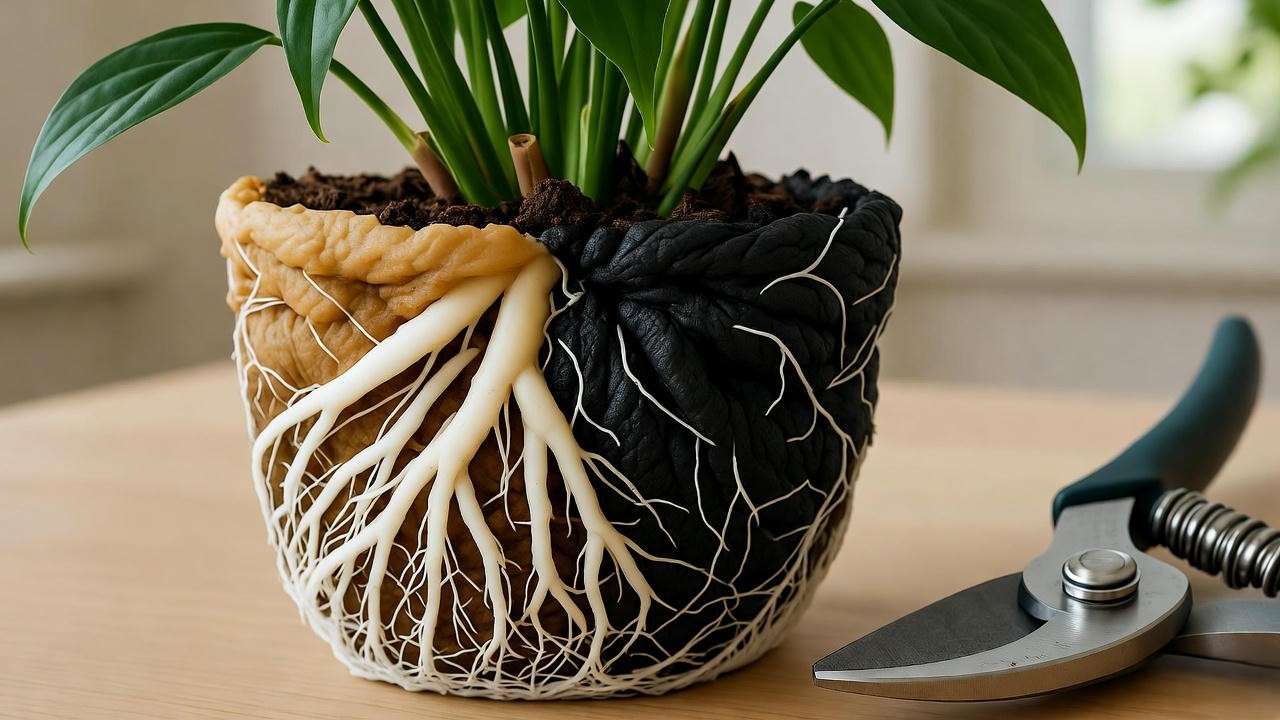
5.3. Symptom 3: Stems Thinning, Elongated, and Pale Red (Etiolation)
- Visual Cue: The stems are visibly stretching and spindly; the distance between the leaves (internodes) is abnormally long; the red/pink color looks washed out or weak.
- Diagnosis: Severe light deficiency. The plant is undergoing etiolation, stretching desperately to find a light source. This weakens the entire stem structure.
- The Fix:
- Immediate Move: Relocate the plant to a location that provides significantly more bright, indirect light.
- Aggressive Pruning: Once the plant has stabilized in the new location, perform aggressive pruning. Cut back the long, leggy stems to encourage bushier, stronger growth from the node below the cut. This helps redirect the plant’s energy into producing compact, healthy stems that can synthesize deeper pigments.
5.4. Symptom 4: Dropping Leaves with Red Stems Intact
- Visual Cue: The leaves are yellowing or dropping off, but the stem itself (especially if it is naturally red) appears firm and healthy, though perhaps a bit dull.
- Diagnosis: Usually a shock response: a sudden drop in temperature, a cold draft from a window, or rapid changes in watering or humidity. This is common in tropical plants like Ficus when they are placed near an AC vent or heating source.
- The Fix: Stabilize the environment. Move the plant away from any vents or drafty windows. Use a simple hygrometer to check the humidity; if it is below 40%, the plant may be dropping leaves to conserve water. Adjust care to be more consistent, avoiding sudden extremes in temperature or moisture.
6. Pro Tip Section: Maintaining Vibrant Stem Color Year-Round 🌈
Moving beyond basic survival, these expert tips will help you not just keep your red stem plant alive, but make its color shine with maximum intensity, elevating it to a true showpiece.
6.1. The 10-Minute Weekly Check-In (Pest Management)
Pests love to hide in the tight crevices where the stem meets the leaf, especially in the nodes and petioles of red-stemmed plants, which offer structural protection. Infestations can drain the plant’s energy, causing stress that manifests as weakened, dull stems.
- Target Areas: Focus your inspection on the undersides of the leaves and where the stem joins the main trunk. Look for cottony white masses (mealybugs), fine webbing (spider mites), or tiny, raised bumps (scale).
- Simple, Non-Toxic Solutions: For small infestations, use a cotton swab dipped in rubbing alcohol to physically remove pests. For prevention and larger issues, treat the plant with a gentle neem oil solution once every two weeks. Never apply neem oil in direct sunlight, as it can cause leaf burn.
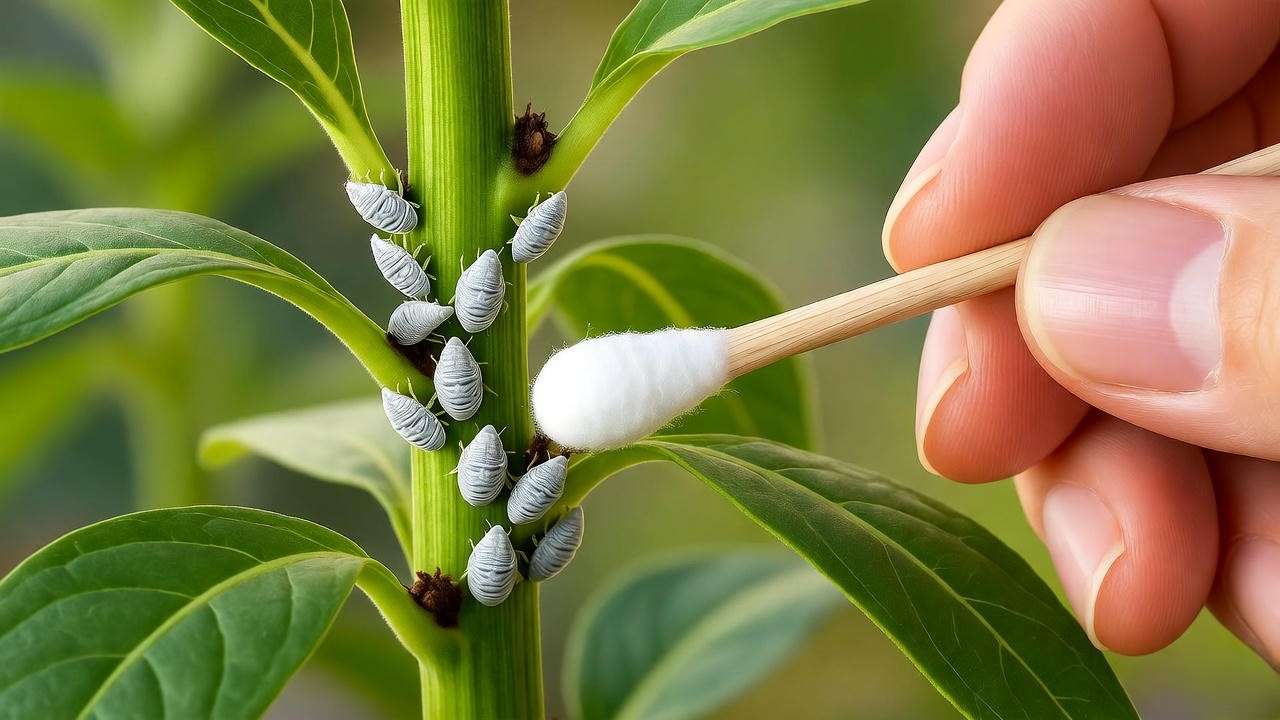
6.2. Pruning for Health and Structure ✂️
Pruning is essential for redirecting the plant’s energy and encouraging the production of new, strongly pigmented growth.
- When to Prune: Always prune during the active growing season (spring and summer).
- The Goal: Cut back weak, pale, or structurally unsound stems. If you have an etiolated (stretched) plant, cutting back the long, spindly stems forces the plant to bush out at a lower, better-lit point.
- Method: Use clean, sharp shears. Cut just above a node (the small bump on the stem where a leaf or bud emerges). This is where the plant’s energy is concentrated to push out new growth. Removing unhealthy sections allows the plant to focus its resources on creating dense, vibrant stems.
6.3. Seasonal Care Adjustments
Care routines must adapt to the seasons, especially since light intensity changes so drastically throughout the year, directly impacting anthocyanin production.
- Winter: This is the plant’s rest period.
- Reduce water dramatically, as the plant uses far less moisture. Overwatering in winter is the fastest route to root rot.
- Stop fertilizing completely.
- Protect from Cold Windows: Move plants several inches back from cold glass or drafty areas, as cold stress is a key trigger for unwanted stem redness and plant shock.
- Summer: This is peak growth season.
- Increase air circulation to prevent fungal issues associated with high humidity and rapid growth.
- Monitor water retention daily, as high temperatures and increased light can cause the soil to dry out rapidly.
7. Frequently Asked Questions (FAQs) (SEO Value) ❓
Targeting these long-tail queries enhances the article’s authority and improves its chances of being featured in Google’s “People Also Ask” snippets.
7.1. Is a red stem always a sign of stress in plants?
No, not always. The key is context and species identification. For plants like the Fiddle Leaf Fig (Ficus lyrata) or Aglaonema, a vibrant red or pink on new growth is a positive sign of health, high light exposure, and active growth. However, a dull, patchy, purplish-red tinge on older, established stems is often a signal of stress, most commonly phosphorus deficiency or cold exposure. Always look at the overall health of the plant before diagnosing based on color alone.
7.2. Which common red stem plant varieties are safe for pets?
Pet safety is a major concern for houseplant owners. Unfortunately, several popular red-stemmed houseplants are toxic. The edible Swiss Chard is completely safe. However, many ornamental varieties are toxic when ingested:
- Ficus lyrata (Fiddle Leaf Fig): Mildly toxic; sap can cause skin irritation.
- Aglaonema (Chinese Evergreen): Toxic; contains insoluble calcium oxalates which cause oral irritation and swelling.
- Hypoestes phyllostachya (Polka Dot Plant): Non-toxic, but ingestion may cause minor stomach upset.
Always consult the ASPCA toxic plant list for specific verification before bringing a new plant home.
7.3. What’s the best way to clean a velvety red stem without damage?
Many red-stemmed plants, particularly the petioles of Ficus or the stems of certain Aglaonema varieties, have a slightly waxy or velvety texture. Dust can accumulate here and interfere with the plant’s ability to photosynthesize.
- Method: Avoid using harsh cloths or scrubbing. Use a soft-bristled brush (like a clean makeup brush) or a damp, lint-free microfiber cloth to gently wipe the dust away.
- Important: If the plant has fine hairs (pubescence), avoid wiping altogether, as you may damage the trichomes. Instead, use a can of compressed air (for electronics) held several inches away to gently blow the dust off.
8. Conclusion: Embrace the Red Stem Plant Challenge 🥇
You now possess the expert knowledge needed to look at any red stem plant and accurately assess its needs. The key takeaways for achieving and maintaining maximum plant health and vibrant color are simple yet powerful:
- ID is King: Accurately identify your species to determine if the red is a feature (health) or a bug (stress).
- Balance Light and Water: Provide bright, indirect light to stimulate pigment production, and master the “Slightly Dry” rule to prevent root rot—the biggest killer of red-stemmed varieties.
- Troubleshoot with Precision: Use the symptom-fix diagnosis chart to pinpoint issues like phosphorus deficiency, etiolation, or infection, and implement corrective measures immediately.
The striking red on your plant’s stem is a tool of communication. It is not a reason to worry, but a brilliant, natural signal that gives you the exact instructions you need to adjust and fine-tune your care routine. Stop ignoring that signal, and watch your plants transform into the vibrant, healthy showpieces they were meant to be.

